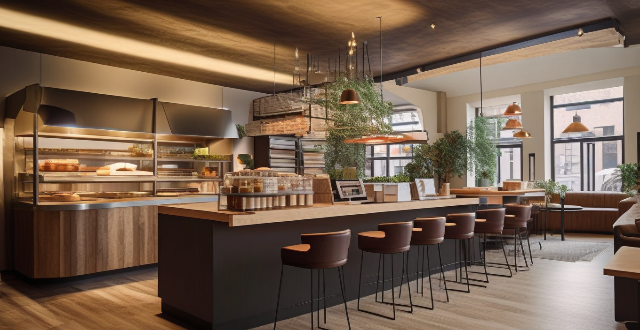Technology and innovation have significantly impacted the restaurant industry by enhancing customer experiences, streamlining operations, and creating new marketing opportunities. Key areas of impact include online ordering and delivery, digital menus and tablets, smart kitchen technology, contactless payment and mobile wallets, social media and online reviews, and artificial intelligence and machine learning. As advancements continue, restaurants must adapt to stay competitive and meet evolving consumer expectations.

Impact of Technology and Innovation on the Restaurant Industry
Introduction
Technology and innovation have revolutionized various industries, including the restaurant industry. From online ordering to digital menus, technology has transformed the way restaurants operate and interact with their customers. In this article, we will discuss how technology and innovation are impacting the restaurant industry.
Online Ordering and Delivery
Increased Convenience for Customers
- Online Ordering: Customers can easily place orders through websites or mobile apps, saving time and effort.
- Delivery Services: With the rise of food delivery platforms like Uber Eats and Grubhub, customers can enjoy their favorite meals at home without leaving their comfort zone.
Improved Efficiency for Restaurants
- Streamlined Processes: Restaurants can manage orders more efficiently by using software that automates order tracking and fulfillment.
- Reduced Overhead Costs: By partnering with third-party delivery services, restaurants can save money on staffing and logistics.
Digital Menus and Tablets
Enhanced Dining Experience
- Interactive Menus: Digital menus allow customers to browse dishes, view photos, and read descriptions, making it easier to choose what to eat.
- Customization Options: Customers can customize their orders directly on the tablet, reducing the chances of errors and improving satisfaction.
Increased Sales and Marketing Opportunities
- Upselling and Cross-selling: Restaurants can use digital menus to promote special offers, daily deals, or popular items, increasing sales opportunities.
- Customer Data Collection: By collecting data on customer preferences and behavior, restaurants can tailor their marketing strategies and improve customer loyalty.
Smart Kitchen Technology
Improved Food Quality and Safety
- Precision Cooking: Smart appliances like sous vide machines and intelligent ovens ensure consistent cooking results, enhancing food quality.
- Temperature Control: Smart thermometers monitor food temperatures in real-time, ensuring safety standards are met throughout the cooking process.
Optimized Workflow and Productivity
- Inventory Management: Smart inventory systems track ingredient usage and expiration dates, minimizing waste and ensuring freshness.
- Energy Efficiency: Smart kitchens reduce energy consumption by automatically adjusting appliance settings based on demand and usage patterns.
Contactless Payment and Mobile Wallets
Faster and More Secure Transactions
- Speedy Payments: Contactless payment options like Apple Pay and Google Wallet enable quick and easy transactions without the need for physical cash or cards.
- Enhanced Security: Mobile wallets provide an additional layer of security by storing payment information securely on devices, reducing the risk of fraud or theft.
Personalized Offers and Loyalty Programs
- Targeted Promotions: Restaurants can send personalized offers to customers based on their payment history and preferences, increasing engagement and repeat visits.
- Loyalty Programs: Integrating loyalty programs into mobile wallets allows customers to earn rewards seamlessly while enjoying discounts and exclusive deals.
Social Media and Online Reviews
Increased Visibility and Brand Awareness
- Social Media Presence: Active social media accounts help restaurants reach a wider audience, showcase their offerings, and engage with customers.
- User-Generated Content: Encouraging customers to share photos and reviews of their dining experiences creates organic marketing opportunities and builds trust among potential patrons.
Transparency and Accountability
- Online Reviews: Positive reviews serve as social proof, attracting new customers and building credibility. Negative reviews provide valuable feedback for improvement.
- Real-time Response: Restaurants can address complaints promptly through social media channels, demonstrating accountability and commitment to customer satisfaction.
Artificial Intelligence and Machine Learning
Personalized Customer Experiences
- AI-powered Recommendations: AI algorithms analyze customer data to suggest tailored menu options based on individual preferences and past orders.
- Chatbots: AI-powered chatbots assist customers in placing orders, answering frequently asked questions, and providing support outside traditional business hours.
Streamlined Operations and Cost Reduction
- Automated Tasks: AI technology automates repetitive tasks such as inventory management, freeing up staff time for more critical responsibilities.
- Resource Optimization: Machine learning algorithms optimize resource allocation by predicting peak periods and adjusting staffing levels accordingly.
Conclusion
Technology and innovation have significantly impacted the restaurant industry by enhancing customer experiences, streamlining operations, and creating new marketing opportunities. As advancements continue, restaurants must adapt to stay competitive and meet evolving consumer expectations.